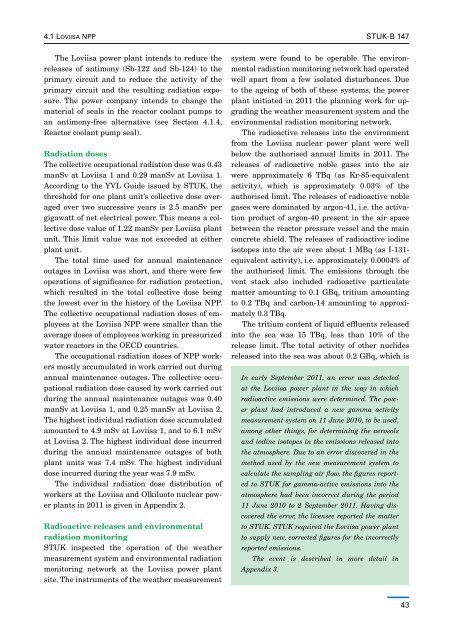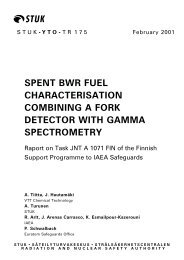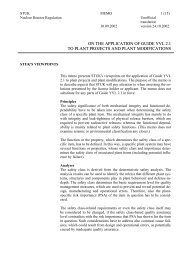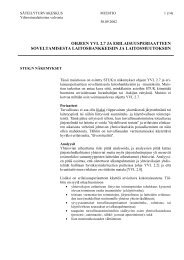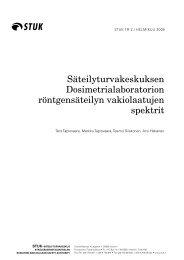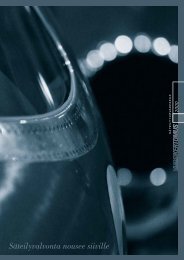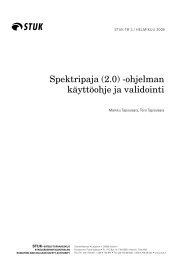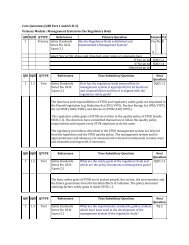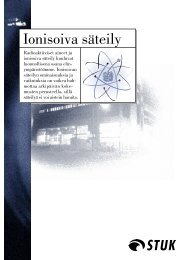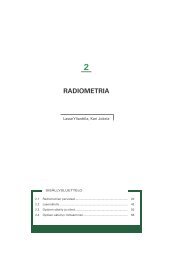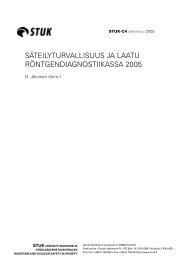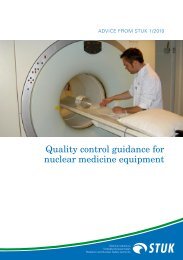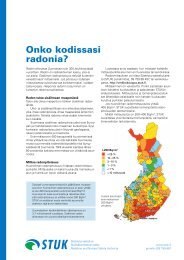Regulatory oversight of nuclear safety in Finland. Annual ... - STUK
Regulatory oversight of nuclear safety in Finland. Annual ... - STUK
Regulatory oversight of nuclear safety in Finland. Annual ... - STUK
You also want an ePaper? Increase the reach of your titles
YUMPU automatically turns print PDFs into web optimized ePapers that Google loves.
4.1 Loviisa NPP<br />
The Loviisa power plant <strong>in</strong>tends to reduce the<br />
releases <strong>of</strong> antimony (Sb-122 and Sb-124) to the<br />
primary circuit and to reduce the activity <strong>of</strong> the<br />
primary circuit and the result<strong>in</strong>g radiation exposure.<br />
The power company <strong>in</strong>tends to change the<br />
material <strong>of</strong> seals <strong>in</strong> the reactor coolant pumps to<br />
an antimony-free alternative (see Section 4.1.4,<br />
Reactor coolant pump seal).<br />
Radiation doses<br />
The collective occupational radiation dose was 0.43<br />
manSv at Loviisa 1 and 0.29 manSv at Loviisa 1.<br />
Accord<strong>in</strong>g to the YVL Guide issued by <strong>STUK</strong>, the<br />
threshold for one plant unit’s collective dose averaged<br />
over two successive years is 2.5 manSv per<br />
gigawatt <strong>of</strong> net electrical power. This means a collective<br />
dose value <strong>of</strong> 1.22 manSv per Loviisa plant<br />
unit. This limit value was not exceeded at either<br />
plant unit.<br />
The total time used for annual ma<strong>in</strong>tenance<br />
outages <strong>in</strong> Loviisa was short, and there were few<br />
operations <strong>of</strong> significance for radiation protection,<br />
which resulted <strong>in</strong> the total collective dose be<strong>in</strong>g<br />
the lowest ever <strong>in</strong> the history <strong>of</strong> the Loviisa NPP.<br />
The collective occupational radiation doses <strong>of</strong> employees<br />
at the Loviisa NPP were smaller than the<br />
average doses <strong>of</strong> employees work<strong>in</strong>g <strong>in</strong> pressurized<br />
water reactors <strong>in</strong> the OECD countries.<br />
The occupational radiation doses <strong>of</strong> NPP workers<br />
mostly accumulated <strong>in</strong> work carried out dur<strong>in</strong>g<br />
annual ma<strong>in</strong>tenance outages. The collective occupational<br />
radiation dose caused by work carried out<br />
dur<strong>in</strong>g the annual ma<strong>in</strong>tenance outages was 0.40<br />
manSv at Loviisa 1, and 0.25 manSv at Loviisa 2.<br />
The highest <strong>in</strong>dividual radiation dose accumulated<br />
amounted to 4.9 mSv at Loviisa 1, and to 6.1 mSv<br />
at Loviisa 2. The highest <strong>in</strong>dividual dose <strong>in</strong>curred<br />
dur<strong>in</strong>g the annual ma<strong>in</strong>tenance outages <strong>of</strong> both<br />
plant units was 7.4 mSv. The highest <strong>in</strong>dividual<br />
dose <strong>in</strong>curred dur<strong>in</strong>g the year was 7.9 mSv.<br />
The <strong>in</strong>dividual radiation dose distribution <strong>of</strong><br />
workers at the Loviisa and Olkiluoto <strong>nuclear</strong> power<br />
plants <strong>in</strong> 2011 is given <strong>in</strong> Appendix 2.<br />
Radioactive releases and environmental<br />
radiation monitor<strong>in</strong>g<br />
<strong>STUK</strong> <strong>in</strong>spected the operation <strong>of</strong> the weather<br />
measurement system and environmental radiation<br />
monitor<strong>in</strong>g network at the Loviisa power plant<br />
site. The <strong>in</strong>struments <strong>of</strong> the weather measurement<br />
<strong>STUK</strong>-B 147<br />
system were found to be operable. The environmental<br />
radiation monitor<strong>in</strong>g network had operated<br />
well apart from a few isolated disturbances. Due<br />
to the age<strong>in</strong>g <strong>of</strong> both <strong>of</strong> these systems, the power<br />
plant <strong>in</strong>itiated <strong>in</strong> 2011 the plann<strong>in</strong>g work for upgrad<strong>in</strong>g<br />
the weather measurement system and the<br />
environmental radiation monitor<strong>in</strong>g network.<br />
The radioactive releases <strong>in</strong>to the environment<br />
from the Loviisa <strong>nuclear</strong> power plant were well<br />
below the authorised annual limits <strong>in</strong> 2011. The<br />
releases <strong>of</strong> radioactive noble gases <strong>in</strong>to the air<br />
were approximately 6 TBq (as Kr-85-equivalent<br />
activity), which is approximately 0.03% <strong>of</strong> the<br />
authorised limit. The releases <strong>of</strong> radioactive noble<br />
gases were dom<strong>in</strong>ated by argon-41, i.e. the activation<br />
product <strong>of</strong> argon-40 present <strong>in</strong> the air space<br />
between the reactor pressure vessel and the ma<strong>in</strong><br />
concrete shield. The releases <strong>of</strong> radioactive iod<strong>in</strong>e<br />
isotopes <strong>in</strong>to the air were about 1 MBq (as I-131-<br />
equivalent activity), i.e. approximately 0.0004% <strong>of</strong><br />
the authorised limit. The emissions through the<br />
vent stack also <strong>in</strong>cluded radioactive particulate<br />
matter amount<strong>in</strong>g to 0.1 GBq, tritium amount<strong>in</strong>g<br />
to 0.2 TBq and carbon-14 amount<strong>in</strong>g to approximately<br />
0.3 TBq.<br />
The tritium content <strong>of</strong> liquid effluents released<br />
<strong>in</strong>to the sea was 15 TBq, less than 10% <strong>of</strong> the<br />
release limit. The total activity <strong>of</strong> other nuclides<br />
released <strong>in</strong>to the sea was about 0.2 GBq, which is<br />
In early September 2011, an error was detected<br />
at the Loviisa power plant <strong>in</strong> the way <strong>in</strong> which<br />
radioactive emissions were determ<strong>in</strong>ed. The power<br />
plant had <strong>in</strong>troduced a new gamma activity<br />
measurement system on 11 June 2010, to be used,<br />
among other th<strong>in</strong>gs, for determ<strong>in</strong><strong>in</strong>g the aerosols<br />
and iod<strong>in</strong>e isotopes <strong>in</strong> the emissions released <strong>in</strong>to<br />
the atmosphere. Due to an error discovered <strong>in</strong> the<br />
method used by the new measurement system to<br />
calculate the sampl<strong>in</strong>g air flow, the figures reported<br />
to <strong>STUK</strong> for gamma-active emissions <strong>in</strong>to the<br />
atmosphere had been <strong>in</strong>correct dur<strong>in</strong>g the period<br />
11 June 2010 to 2 September 2011. Hav<strong>in</strong>g discovered<br />
the error, the licensee reported the matter<br />
to <strong>STUK</strong>. <strong>STUK</strong> required the Loviisa power plant<br />
to supply new, corrected figures for the <strong>in</strong>correctly<br />
reported emissions.<br />
The event is described <strong>in</strong> more detail <strong>in</strong><br />
Appendix 3.<br />
43


